Mercedes E Class vs Skoda Kodiaq – Which car suits you better?
Compare performance, boot capacity, efficiency and price at a glance.
Find out which car is the better choice for you – Mercedes E Class or Skoda Kodiaq?
Costs and Efficiency:
Price and efficiency are key factors when choosing a car – and this is often where the real differences emerge.
Skoda Kodiaq has a noticeable advantage in terms of price – it starts at 36800 £, while the Mercedes E Class costs 50500 £. That’s a price difference of around 13642 £.
Fuel consumption also shows a difference: Skoda Kodiaq manages with 0.40 L and is therefore convincingly more efficient than the Mercedes E Class with 1.50 L. The difference is about 1.10 L per 100 km.
As for range, the Skoda Kodiaq performs minimal better – achieving up to 123 km, about 7 km more than the Mercedes E Class.
Engine and Performance:
Power, torque and acceleration are the classic benchmarks for car enthusiasts – and here, some clear differences start to show.
When it comes to engine power, the Mercedes E Class has a convincingly edge – offering 585 HP compared to 265 HP. That’s roughly 320 HP more horsepower.
In acceleration from 0 to 100 km/h, the Mercedes E Class is clearly quicker – completing the sprint in 4 s, while the Skoda Kodiaq takes 6.30 s. That’s about 2.30 s faster.
In terms of top speed, the Mercedes E Class performs minimal better – reaching 250 km/h, while the Skoda Kodiaq tops out at 231 km/h. The difference is around 19 km/h.
There’s also a difference in torque: Mercedes E Class pulls decisively stronger with 750 Nm compared to 400 Nm. That’s about 350 Nm difference.
Space and Everyday Use:
Cabin size, boot volume and payload all play a role in everyday practicality. Here, comfort and flexibility make the difference.
Both vehicles offer seating for 5 people.
In curb weight, Skoda Kodiaq is barely noticeable lighter – 1684 kg compared to 1810 kg. The difference is around 126 kg.
In terms of boot space, the Skoda Kodiaq offers clearly more room – 910 L compared to 540 L. That’s a difference of about 370 L.
When it comes to payload, Mercedes E Class a bit takes the win – 640 kg compared to 545 kg. That’s a difference of about 95 kg.
Who wins the race?
The Skoda Kodiaq proves to be is largely superior and therefore becomes our DriveDuel Champion!
Skoda Kodiaq is the better all-rounder in this comparison.
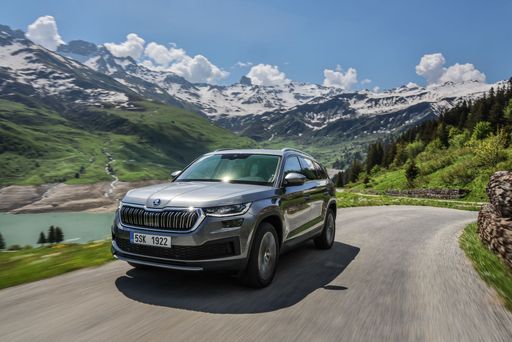
Skoda Kodiaq
Mercedes E Class
The Mercedes-Benz E-Class Saloon epitomises sophistication and innovation, offering a seamless blend of elegant design and cutting-edge technology. Its refined interior ensures exceptional comfort, making every journey a luxurious experience. The driving dynamics are impressively balanced, providing both agility and smoothness, perfect for both city driving and long-distance cruising.
details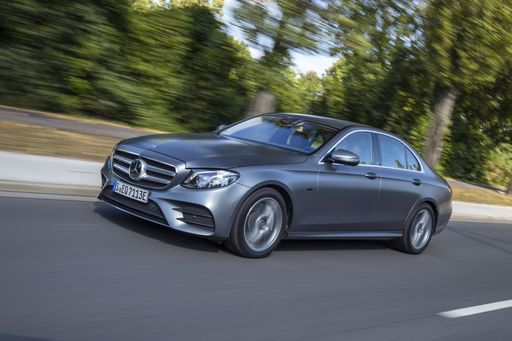 @ group-media.mercedes-benz.com
@ group-media.mercedes-benz.com
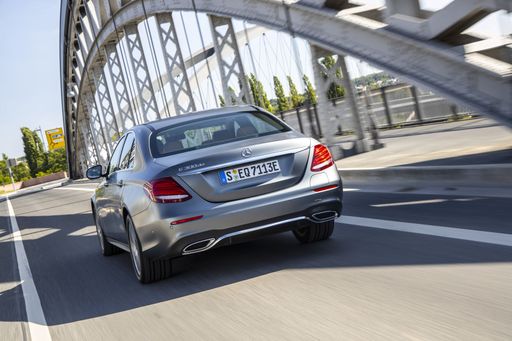 @ group-media.mercedes-benz.com
@ group-media.mercedes-benz.com
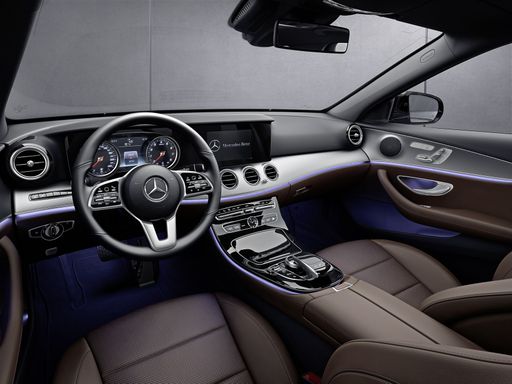 @ group-media.mercedes-benz.com
@ group-media.mercedes-benz.com
Skoda Kodiaq
The Škoda Kodiaq impresses with its spacious interior and sleek design, making it a popular choice for families and adventurers alike. Equipped with a range of modern features, it offers a comfortable driving experience and outstanding versatility. Its robust build and refined handling make it suitable for both urban settings and countryside escapades.
details @ skoda-media.de
@ skoda-media.de
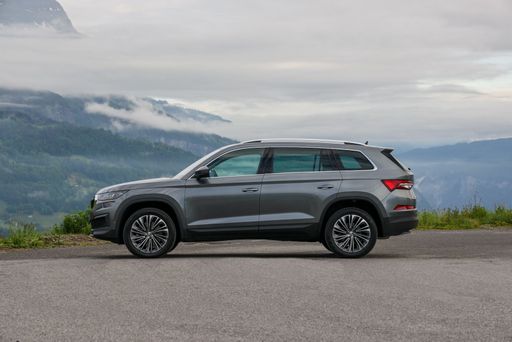 @ skoda-media.de
@ skoda-media.de
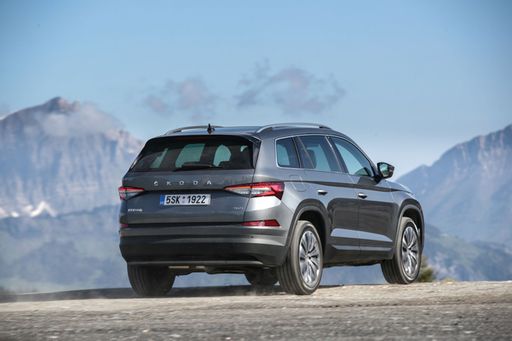 @ skoda-media.de
@ skoda-media.de
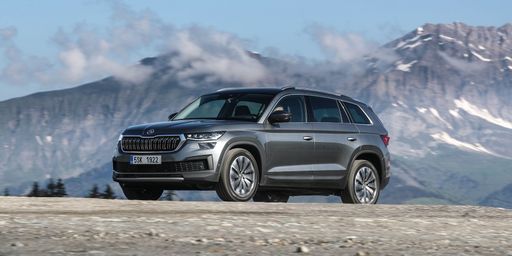 @ skoda-media.de
@ skoda-media.de
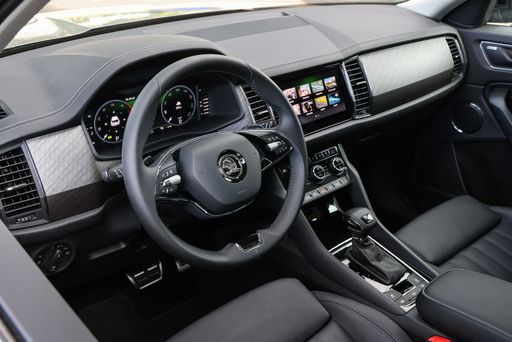 @ skoda-media.de
@ skoda-media.de

|

|
|
|
|
Costs and Consumption |
|
|---|---|
|
Price
50500 - 119700 £
|
Price
36800 - 49600 £
|
|
Consumption L/100km
1.5 - 7.5 L
|
Consumption L/100km
0.4 - 8.2 L
|
|
Consumption kWh/100km
-
|
Consumption kWh/100km
-
|
|
Electric Range
101 - 116 km
|
Electric Range
113 - 123 km
|
|
Battery Capacity
21.20 kWh
|
Battery Capacity
19.70 kWh
|
|
co2
39 - 172 g/km
|
co2
9 - 186 g/km
|
|
Fuel tank capacity
50 - 66 L
|
Fuel tank capacity
45 - 58 L
|
Dimensions and Body |
|
|---|---|
|
Body Type
Sedan
|
Body Type
SUV
|
|
Seats
5
|
Seats
5
|
|
Doors
4
|
Doors
5
|
|
Curb weight
1810 - 2390 kg
|
Curb weight
1684 - 1970 kg
|
|
Trunk capacity
370 - 540 L
|
Trunk capacity
745 - 910 L
|
|
Length
4949 - 4959 mm
|
Length
4758 - 4761 mm
|
|
Width
1880 mm
|
Width
1864 mm
|
|
Height
1468 - 1480 mm
|
Height
1663 - 1683 mm
|
|
Max trunk capacity
-
|
Max trunk capacity
1945 - 2105 L
|
|
Payload
530 - 640 kg
|
Payload
460 - 545 kg
|
Engine and Performance |
|
|---|---|
|
Engine Type
Petrol MHEV, Plugin Hybrid, Diesel MHEV
|
Engine Type
Plugin Hybrid, Petrol, Petrol MHEV, Diesel
|
|
Transmission
Automatic
|
Transmission
Automatic
|
|
Transmission Detail
Automatic Gearbox
|
Transmission Detail
Dual-Clutch Automatic
|
|
Drive Type
Rear-Wheel Drive, All-Wheel Drive
|
Drive Type
Front-Wheel Drive, All-Wheel Drive
|
|
Power HP
186 - 585 HP
|
Power HP
150 - 265 HP
|
|
Acceleration 0-100km/h
4 - 8.5 s
|
Acceleration 0-100km/h
6.3 - 9.7 s
|
|
Max Speed
222 - 250 km/h
|
Max Speed
205 - 231 km/h
|
|
Torque
320 - 750 Nm
|
Torque
250 - 400 Nm
|
|
Number of Cylinders
4 - 6
|
Number of Cylinders
4
|
|
Power kW
137 - 430 kW
|
Power kW
110 - 195 kW
|
|
Engine capacity
1993 - 2999 cm3
|
Engine capacity
1498 - 1984 cm3
|
General |
|
|---|---|
|
Model Year
2024 - 2025
|
Model Year
2024 - 2025
|
|
CO2 Efficiency Class
E, F, B, D
|
CO2 Efficiency Class
B, F, G, E
|
|
Brand
Mercedes-Benz
|
Brand
Skoda
|
Is the Mercedes E Class offered with different drivetrains?
The Mercedes E Class is offered with Rear-Wheel Drive or All-Wheel Drive.
The prices and data displayed are estimates based on German list prices and may vary by country. This information is not legally binding.
